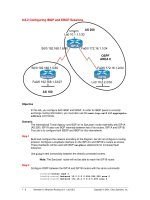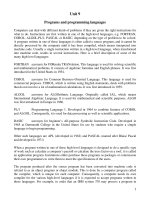Tài liệu International Monetary and Financial Committee pdf
Bạn đang xem bản rút gọn của tài liệu. Xem và tải ngay bản đầy đủ của tài liệu tại đây (159.75 KB, 11 trang )
International Monetary and
Financial Committee
Twenty-Seventh Meeting
April 20, 2013
Statement by Angel Gurria, Secretary-General, Organisation for Economic
Co-operation and Development
On behalf of Organisation for Economic Co-operation and Development
IMF/WB Spring Meetings
Written Statement for the IMFC
Remarks by Angel Gurría,
Secretary-General
OECD
20
th
April 2013
Washington, United States
1
Global Economic Outlook
After a marked slowdown in late 2012, the global economy appears now to be picking up.
Output growth was weak in most advanced countries in the last quarter of 2012 and the
increase in global trade volumes came to a virtual halt. Growth among emerging economies
has remained much faster than that of advanced countries on average, although with
significant differences across countries.
The outlook in the first half of 2013 is for a return to moderate growth in the United States
and an acceleration from low levels in Japan, boosted by new policy measures. In Europe, a
meaningful recovery is likely to take somewhat longer but prospects for the euro-area should
improve during the year. The receding of negative tail risks in the United States and the euro
area in late 2012 and early 2013, together with abundant liquidity, was an important factor
behind the marked strengthening of financial markets in recent months. Equity prices in
OECD economies have surged, corporate bond spreads have narrowed and, despite a
number of negative shocks, sovereign spreads in the euro area periphery moved down
substantially in the last quarter of 2012 and have declined further in 2013.
This builds also on the policy actions taken in recent years, including the effect of supportive
monetary policy. Fiscal consolidation and structural reforms are progressing, especially in the
euro area where great strides have been made to reduce structural budget deficits. Albeit
asymmetric, the process of euro area rebalancing is underway and competitiveness is
adjusting.
2
However, despite the recent news, the situation remains fragile and a sustainable recovery is
yet to be secured.
In the euro area, the on-going deep recessions in Italy and Spain - as well as the virtual
standstill in France – raise serious questions about the recovery and remain a threat to the
achievement of fiscal consolidation plans and the stability of the financial system. Within the
euro area, there is a renewed divergence between growth in Germany, which is likely to
achieve moderate growth in the first half of 2013, and that of other countries, which is
projected to remain slow or negative.
Labour market slack remains substantial in many OECD countries, and the employment
situation has continued to deteriorate in the euro area, contributing to depressed consumer
confidence. In Europe especially, the rise of long-term unemployment, with more of the
unemployed moving off unemployment insurance onto less generous social benefits, is
worsening poverty and inequality. Even in the United States, where job growth has been
reasonably strong in recent quarters, the proportion of the working-age population in
employment remains well below pre-crisis levels and has risen only slightly from its post-
crisis lows. In Japan, the unemployment rate has been declining since mid-2009, but is still
higher than in 2007.
There is also a risk that global imbalances and financial stability issues have not been
addressed adequately and problems will emerge again as the economy picks up. In most
advanced economies, banks’ efforts to repair balance sheets remain ongoing. This is holding
back loan growth. Bank lending has recently picked up somewhat in the United States, the
United Kingdom and Switzerland. But in the euro area, it has continued to contract, even
before the hit to confidence from the drawn-out resolution of the banking crisis in Cyprus.
The fragmentation and fragility of the banking system remains fundamentally at the heart of
weak credit availability and low growth in the eurozone. This is of great concern as the
3
European economy is much more dependent on bank finance than the US economy. And the
euro area remains the region where negative tail risks appear most prominent, because
feedback loops between banking system fragility and government debt burdens have not
been severed. A full banking union is needed for the euro area, not just for the future but also
to get the economy moving again.
Financing of long-term investment is made difficult not only by the lack of banking credit but
also by the rarefaction of equity finance. With the compression of yields, the preference for
debt-financing has increased at the expense of equity, which is essential for the financing of
long-term investment, especially for new ventures and high-growth innovative firms.
Furthermore, in an environment of weak sales growth and high uncertainty, corporates have
been hoarding cash and privileging dividends and share buybacks at the expense of
investment. This is particularly noticeable in some key sectors like technology and
healthcare. In this uncertain post-crisis environment, companies that give cash back to
shareholders tend to be favoured by equity markets, punishing companies that embark on
long-term investment.
More generally, global financial markets show signs of renewed exuberance that is
increasingly out of line with fundamentals. This gaping disconnect between the financial
sector and the real economy should be a source of concern. In particular, large banks’
business models have not changed enough from the pre-crisis era. Banks remain over-
reliant on trading activities and derivatives. In light of the recent compression of yields, a
sharp correction in debt markets cannot be ruled out that would worsen the already fragile
financial situation of many banks in OECD countries, in the euro-area in particular. Also,
markets in some emerging economies show signs of overheating and are witnessing
worrying credit booms.
4
Macroeconomic policy directions
As a self-sustained recovery is not fully assured, bold policy action to support activity
remains necessary in all major OECD economies. Demand in many countries still faces
strong headwinds from private-sector deleveraging, necessary fiscal consolidation and
impaired bank credit provision.
Given limited fiscal space in most OECD countries, monetary policy remains a key
instrument for supporting demand, even though monetary stimulus may not always be
sufficient to close output gaps quickly and carries its own risks. In some economies,
especially within the euro area, the transmission of monetary easing to the real economy is
impaired. Notwithstanding the risk of fuelling asset price bubbles or of policy encouraging
excessive risk-taking, in most major OECD economies low underlying inflation rates give
room for monetary policy action, and exceptional measures should remain in place for now
and in some cases be pursued further.
In the United States, the real economy appears to be responding to monetary easing, as
household consumption has picked up and the housing sector has begun to rebound, despite
fiscal headwinds. The forward guidance from the Federal Reserve, whereby policy rates will
be kept low as long as unemployment remains above 6.5 per cent and projected inflation
remains below 2½ per cent, appears well judged in current circumstances, providing
assurance that monetary conditions will be supportive of demand while it is needed. As to
quantitative easing, the point where the costs of further increasing the pace of asset
purchases outweigh the benefits is likely to be within sight, but skilful judgement will be
required to gauge the speed at which asset purchases can be phased out.
5
In Japan, the prospect of more aggressive monetary easing had already resulted in a 20%
depreciation of the yen in real effective terms and a surge in equity prices even before the
recent announcement from the Bank of Japan which specified details of the measures to be
adopted in order to meet the new 2% inflation target. The boldness of the moves have
boosted confidence and improved the chances of escaping from deflation and achieving
more satisfactory output growth.
Further measures to repair the credit transmission mechanism are most needed in the euro
area, especially in crisis countries where there are strong headwinds from private and public
deleveraging and there is a need to reorient economies to export activities. Rapid progress
must be made to implement a comprehensive system of common banking supervision with
clear crisis resolution and support mechanisms, as part of a process of returning banks to
good health. The recent Cypriot crisis, while an exceptional case, shows the importance of
addressing banking crises directly and decisively, but also of putting in place the right
institutions at the euro area level to maintain banking system stability.
Reforms to the global financial system
At their meeting in Moscow in February G20 Finance Ministers and Central Bank Governors
recognised that long-term financing for investment is a key contributor to economic growth
and job creation The OECD will prepare a report on “High-Level Principles of Long-term
Investment Financing by Institutional Investors” for the G20 Leaders Summit in September
2013.
Regarding financial reforms, progress has been made but perhaps not as fast and as
coordinated as many may have hoped for. The pressure for reforms is weakening, and
against a background of weak economies and fragile banking sectors, regulators have eased
some of the planned reforms, in particular those concerning the liquidity rules. There are in
6
fact many unfinished issues on the financial reform agenda, including harmonising
accounting rules to enhance transparency; introducing a simple, binding leverage ratio in the
Basel rules; and finding ways to better limit contagion and address the too-big-to-fail problem
by structural banking reforms, e.g. the separation and ring-fencing of banks’ activities.
There are also recurrent discussions at the international level pertaining to the merits of
introducing restrictions on capital flows, notably aimed at taming massive inflows of short-
term capital and preventing a massive appreciation in the exchange rate of the domestic
currency. These discussions are legitimate, but should not lead to uncoordinated and
beggar-thy-neighbour policy actions. For more than fifty years, the OECD Codes of
Liberalisation of Capital Movements and Current Invisible Operations have provided a
framework for promoting transparency and mutual accountability, sharing experiences with
progressive liberalisation, and supporting countries at times of economic and financial
disturbance. The Codes can play a role when countries need to take measures to ensure
financial stability, with a variety of provisions enabling countries to introduce restrictions on
capital flows. At the same time, restrictions should not be used to substitute for exchange
rate and other needed policy adjustments. Moreover, it is important that restrictive measures
are taken within an agreed framework of international dialogue and cooperation so as to
avoid negative spillover effects and entering into a spiral of measures and countermeasures.
The Codes offer such a framework. Since June 2012 they are open to adherence by all
interested countries outside the OECD membership with equal rights as OECD countries.
This is an important step in expanding international co-operation, maintaining deep liquid
global capital markets, and making the most of international capital flows as a tool to finance
growth and development. Time has also come to think about how the Codes should be
improved to ensure we can continue to maximise the benefits from open capital markets
while avoiding their downside effects.
7
Creating jobs and protecting the vulnerable
The economic and financial crisis continues to cast its long shadow on the labour market,
with many countries facing high levels of unemployment and underemployment as well as
rising long-term unemployment. Youth, the low-skilled and immigrants have been hit the
hardest, but no group has been spared. Restarting the jobs machine remains therefore
essential.
The first response should be to restore confidence and growth, so as to stimulate job
creation. However, it is also essential to ensure that effective support is provided to the
unemployed and those at risk of falling into poverty and exclusion. Governments should also
undertake structural reforms aimed at strengthening formal sector job creation and improving
job quality. The OECD welcomes the joint meeting of the G20 Finance and Labour Ministers,
which will be an opportunity to discuss mutually reinforcing actions on the macroeconomic,
labour market and social policy fronts to support stronger, sustainable growth and better
employment outcomes.
Even countries facing severe fiscal constraints can be smarter in designing labour market
policies and targeting support to the individuals most in need using cost effective measures.
For example, hiring subsidies should be targeted at helping the most disadvantaged groups
— such as the long-term unemployed and out-of-work youth — back into jobs, while avoiding
subsidising jobs that would have been created anyway. A number of countries have also
demonstrated the value of work experience programmes for keeping these groups connected
to the world of work, for example the Jovenes programmes in several Latin American
countries. Publicly subsidised training programmes can also play a useful role provided they
are closely coordinated with employers to assure that training meets existing skill needs.
8
Structural labour market reforms also have a role to play. Several European countries,
notably Greece, Italy, Portugal and Spain, have embarked on ambitious labour market
reforms recently. If fully implemented, they will encourage the creation of more and better
quality jobs and improve the chances of many, including the youth and other new entrants to
the labour market. But especially given the difficult labour market context, special attention
should be given to supporting the most vulnerable groups in the transition. Moreover, these
reforms should be accompanied by competition-enhancing product market reforms in service
sectors, such as retail trade and professional services. Tax simplification and extensions of
social insurance coverage are among the measures that can help to tackle high rates of
informality in many emerging and developing economies.
Structural policies to facilitate rebalancing and raise growth rates
In some cases, structural factors that contributed to the crisis and led to growing external
imbalances have yet to be fully addressed. Meanwhile, the depth and duration of the crisis
have resulted in higher overall and especially long-term unemployment, while policy
responses to restore growth have saddled many advanced economies with heavy public debt
burdens. In these circumstances, structural reform will have a large role to play in achieving
stronger, more sustainable and fairer growth.
Many OECD countries have the potential to reduce costly distortions in the tax system and
widen the tax base. In the euro area and Japan, there is scope to reduce restrictive product
market regulations that limit competition and hold back investment. Regulatory and
institutional barriers to labour market participation as well as labour market dualism should
be reduced, while improving programmes to help the unemployed find work. Some euro area
countries need to use structural reforms to reduce relative unit labour costs to reverse earlier
losses in competitiveness, allowing them to achieve both internal and external balance. In
some cases, this process is well underway, which is welcome. Structural reforms are
9
generally less well advanced among euro area countries with current account surpluses, and
more active reforms in these countries could help reconcile the need for rebalancing with a
resumption of growth in the euro area as a whole.
Emerging market economies are also confronting many challenges, which vary across
countries, but common themes include weak innovation, high barriers to competition,
inefficient education or health systems, a high degree of informality in the labour market, and
low-quality infrastructure. Removing these bottlenecks would help to secure strong,
sustainable and inclusive growth in these countries while also helping to reduce global
imbalances.
More must be done to facilitate trade and integration into global value chains. Adopting a
liberal trade and investment regime and a pro-competitive regulatory stance in key service
sectors will be essential for countries, both advanced and emerging, to maximise the benefits
from the internationalisation of services markets.
Substantial progress is being made on structural reform in some countries. Notably, while
growth in the euro area has continued to disappoint, the underlying rebalancing of the
economy is well underway, even if it still has some way to go. Structural reforms, notably in
Greece, Ireland, Italy, Portugal and Spain, provide a solid base for a recovery in
competitiveness and an increase in employment when demand turns around. Considerable
progress has been made on reducing structural budget deficits, and in most euro area
countries the largest part of the fiscal adjustment required after the crisis has already been
undertaken. The short-term costs of these adjustments would be reduced by an improved
supply of credit in debtor countries and structural reforms that help to rebalance activity and
demand in surplus economies.









